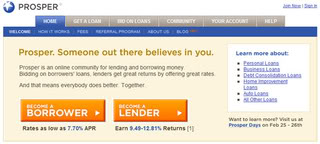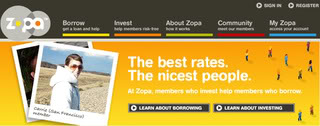You’ve heard of social networking sites like MySpace and FaceBook…but have you heard of social lending sites?
Forecast for the Week- Patrick Dunn, Westwood Mortgage Inc. & MMG Weekly
patrick@westwoodmortgage.com / http://www.certifiedplanning.com/
Over the past few years, several websites have sprung up that combine features of the omnipresent social networking sites, and commerce sites like eBay. These sites allow individuals to become either a borrower from or a lender to the online community. The website collects basic financial information from would be borrowers, as well as the intended purpose for the money. The site then posts a short profile of the borrower, so that other members of the community can choose to lend money to them or not.
 The very first created was www.Prosper.com, which allows individuals to borrow and lend small amounts of money, for any variety of purposes. Recent posts include families wanting to start a small business and a father seeking to pay off his son’s medical bills…you can see their pictures and read their stories. The maximum loan amount is $25,000 – and lenders can borrow as little as $50 towards someone’s total desired loan amount, and determine what rate they are willing to lend at based on the individuals credit standing and risk profile. Prosper encourages lenders to fund small amounts towards many individuals loans, to help minimize risk of default. Why consider it? Although risk of default is certainly a potential – because these are generally individuals unable to borrow via more traditional methods – it is quite a learning experience, and the rate of return will be higher than via a traditional savings account.
The very first created was www.Prosper.com, which allows individuals to borrow and lend small amounts of money, for any variety of purposes. Recent posts include families wanting to start a small business and a father seeking to pay off his son’s medical bills…you can see their pictures and read their stories. The maximum loan amount is $25,000 – and lenders can borrow as little as $50 towards someone’s total desired loan amount, and determine what rate they are willing to lend at based on the individuals credit standing and risk profile. Prosper encourages lenders to fund small amounts towards many individuals loans, to help minimize risk of default. Why consider it? Although risk of default is certainly a potential – because these are generally individuals unable to borrow via more traditional methods – it is quite a learning experience, and the rate of return will be higher than via a traditional savings account.
 Another similar site is www.Zopa.com – also a social lending site, but with a few key differences. If a borrower request is approved, Zopa funds it directly, raising funds by offering Certificates of Deposit (CD) to be purchased with attractive rates of return. If you purchase a CD, you are required to choose at least one borrower request to sponsor. By sponsoring a borrower you marginally reduce the interest rate earned on your CD, which in turn is used to reduce the rate that the borrower is paying. Best of all, your money and your rate of return is guaranteed and insured.
Another similar site is www.Zopa.com – also a social lending site, but with a few key differences. If a borrower request is approved, Zopa funds it directly, raising funds by offering Certificates of Deposit (CD) to be purchased with attractive rates of return. If you purchase a CD, you are required to choose at least one borrower request to sponsor. By sponsoring a borrower you marginally reduce the interest rate earned on your CD, which in turn is used to reduce the rate that the borrower is paying. Best of all, your money and your rate of return is guaranteed and insured.
Perhaps the most intriguing of the social lending sites, www.Kiva.org is a blend of charitable giving and online lending. This site specializes in very small loans made to individuals in third world countries. The loans requests and photos are fascinating…who knew that a cow could be purchased for only $500, or that you could literally purchase tons of coffee and cocoa for $1000? The downside to Kiva is that the loan is not repaid with interest, and because it is a loan and not a charitable contribution, it is not tax deductible. But the upside – helping those in developing countries create and expand their businesses, provide for their families and improve their countries economy as a whole – well, this offers a substantial rate of return, just of a different type.
And consider getting your kids involved. Parents can use sites like these to help instill a sense of giving back, as well as a broader view of the economic world. Start with a small amount of money, and let them decide who to lend it to and why. When the loan is repaid, turn around and lend it again. It’s never too early to get kids involved in the process of understanding money, lending, and the world around them as a whole.
